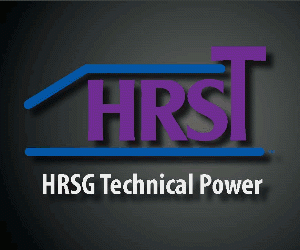Special to CCJ ONSite by Brian Hulse, BDHulse Consulting Services LLC
 Seems like a simple enough question. It gets asked thousands of times a day in restaurants around the world. But in generating plants powered by gas turbines, it takes on a whole different meaning. These engines are very sensitive to salt, and there are strict limits on its ingestion. Just a few parts-per-million can quickly lead to a multi-million-dollar repair bill.
Seems like a simple enough question. It gets asked thousands of times a day in restaurants around the world. But in generating plants powered by gas turbines, it takes on a whole different meaning. These engines are very sensitive to salt, and there are strict limits on its ingestion. Just a few parts-per-million can quickly lead to a multi-million-dollar repair bill.
That’s all good to know, but the fact of the matter is that our plants get sited where they make functional and fiscal sense, not on the druthers of equipment manufacturers.
We have learned from work done in Hungary’s Institute for Atmospheric Physics (by L Horvath, E Mfiszaros, and E Antal) and Central Institute for Meteorology (by A Simon), that marine air basically contains two kinds of aerosol particles: Those with radii larger than about 0.5 microns composed of sea salt (NaCl), and smaller particles of mostly sulfur species formed in the air by gas-to-particle conversion (excess sulfate). These particles are found in the atmosphere up to 11 miles from the seashore.
OEMs frown on sodium (Na) and sulfur (S) entering their engines, but just how much sodium are we really talking about here? Sure, you can taste the salt in the air when you’re at the beach, but how dense can it really be 11 miles inland?
So, let’s take the mid-point—5.5 miles—from the shore for illustrative purposes. Assume the gas turbine at that location is an unfiltered LM2500 (base model with a single annular combustor). Based on the work of the Hungarian researchers and the amount of air the example engine swallows during an 8200-fired-hour base-loaded year, the GT would ingest a little more than 5 lb of salt.
Even if you don’t add the sodium that enters the engine through other vectors (fuel, steam, water injection), you are way over the limit GE recommends for this machine.
Managing salts and sulfur in the non-air vectors can—and usually is—done through a combination of contractual obligations and plant processes. Managing the air is really down to one tool: filtration. The design, installation, operation, and maintenance of the combustion-air filtration system is the sole line of defense. What about them should we be concerned with if we find ourselves in a plant sited within 11 miles of a saltwater coastline? Well, here are a few thoughts:
Design. Some packagers only have one combustion-air filtration option, but others have multiple options that are designed for specific environments (desert, marine, etc). If options are available, ticking the appropriate box is a great first step. If options are not available, consider asking for a customized unit, or deleting the inappropriate unit and seeking options in the aftermarket (they are available).
Installation. When the construction team is assembling the combustion-air intake, some oversight/sign-off hold points are a good idea. Pay particular attention to the following:
-
- Make sure the structure’s bolted flanges are made up tight, and that the gasketing is centered up on the bolt line as it should be.
- Check the structural alignment and grouting of the support legs to ensure that there isn’t going to be any sagging or tweaking of the structures that could lead to cracking of welds or flange separations.
- Verify the proper alignment of any expansion joints or bellows in the ductwork; no binding allowed. And make sure there are no gaps or tears in these components that would allow air (and contaminants) to enter.
- Check the interior materials and coatings—especially downstream of the high-efficiency filter elements—to ensure they are in good condition and sufficiently robust to withstand the corrosive effects of a marine environment.
- Check the man-doors to be sure they are hung straight and square to promote good sealing.
- Inspect door gaskets for proper attachment; also, that latches are adjusted for firm closure. Same for inspection hatches—straight, square, and good tight gaskets.
Operations. Make regular checks on all possible ingress points during routine rounds. Monitor differential pressures (DPs) throughout the ductwork. Make sure all of the transmitters and gauges are in good working order. The DPs should be going progressively up as you get further into the duct—never down. The only time you should see a reduction is following a maintenance activity (filters replaced, etc).
Do not run the DPs past OEM-established alarm limits. When the unit is down and it is safe (an inlet entry protocol should be in place and adhered to at all times), go inside, close the door and look for light. If light can get in, air (and contaminants) can get in too. Make sure any deterioration noted is captured in work orders for the maintenance team to follow up on.
Maintenance. Obviously, keeping all of the instrumentation working and calibrated is a must. Filters must be changed as needed. All surfaces must be preserved with appropriate prep work and coatings. Your packager will have coating specifications available. When spot-priming areas between coating refurbishments, make sure you don’t use something that could harm the gas turbine (like a primer containing zinc).
If the structure’s bolted flanges start opening up, retighten the bolts and consider seal-welding the flanges at your next maintenance opportunity. As long as you’re not a mobile installation, it is a good “final fix” tactic. As the equipment ages, it will become more and more needy in terms of maintenance. Make sure those needs are accounted for in your budgets and manpower planning.
Finally, there are a lot of resources out there in the aftermarket that can provide guidance in filter application, system modifications (such as adding demister pads or torturous-path particulate pre-filters, etc), and O&M advice on best practices. Take advantage of them. Listen closely, ask questions for clarification. Be data-driven and choose the path forward that is best for you and your plant. It’s never a “one-size-fits-all” proposition, and if someone tells you it is, ask for the data.





